Rehydrating Mexican Chiles
We modern foodie types are used to doing a lot of Continental cooking: French and Italian especially. So when we see a red or red-brown sauce we automatically assume there’s tomato in it. But in fact a lot of deep red and rust-colored Mexican sauces don’t have any tomato in them at all, just puréed chile pepper. Reconstituted dried chile pepper to be more exact.
You see them in Mexican grocery stores or international aisles in supermarkets, packaged in crackling cellophane bags. If you’ve ever looked those over and wondered what the heck you do with them, I’m here today to show you. But first you need to know that not all dried chiles are not equal. Some are much, much drier than others, and that can be a bad thing when it comes to say, making a tamal or enchilada sauce.
If you buy them where there’s a decent turnover, they’ll be dry but not brittle, and that’s what you want. You want chiles that are nice and flexible, that you can bend like this without them breaking. Like so:
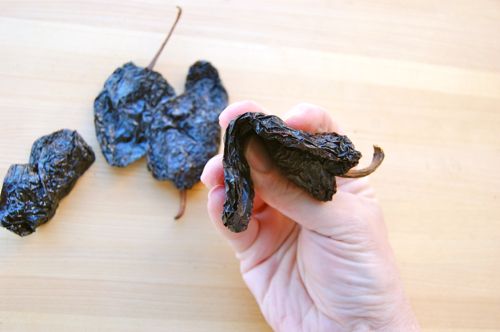
If they don’t do that, then your odds of creating a great sauce are vastly diminished. Find another grocer with fresher products.
To begin processing them, tear them open. Just use your bare hands, they chiles won’t do anything to you. Tear off the stem and open the sucker up. You’ll find seeds inside. Shake them out.

Next, tear the chile into pieces about yay big:
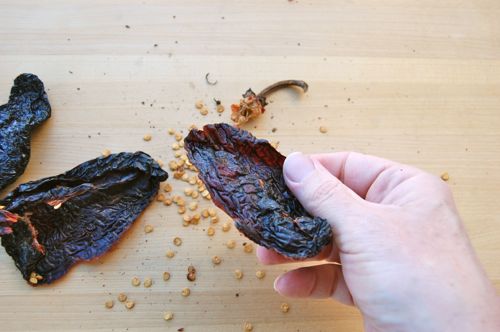
When they’re all seeded and torn up, heat up a skillet — cast iron is perfect for this — over medium-high heat. Lay a chile strip in. No oil or fat of any type is needed here.
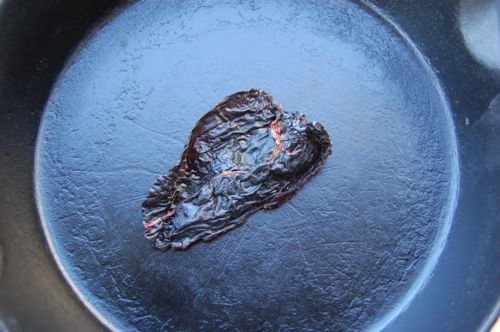
Using a heavy spatula, press the chile down onto the hot surface. After a few seconds, you’ll feel the spatula rise a little as the small amounts of moisture in the chile turn to steam and cause the flesh to bubble (these bubbles are what will allow moisture in so the flesh can reconstitute). This should take about 30 seconds.

When you start to see the odd puff of smoke, flip the chile piece over. It should be orange-colored and blistered.
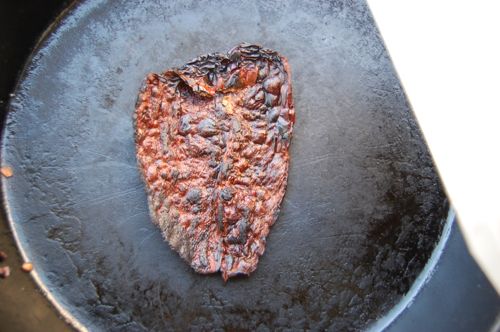
Repeat the pressing for about 30 more seconds until the second side looks like the first.

Place the chiles in a bowl and pour boiling water over them. If they float too much, weigh them down with a spoon, cup or saucer.

After half an hour of steeping they’ll look like this:
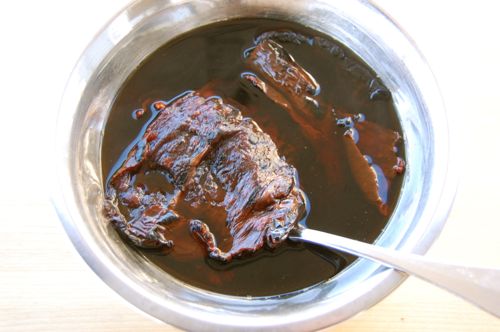
At this point they’re ready to purée with onion, spices and some of that steeping liquid (and/or chicken stock) to make a chile sauce base. If you’re wondering whether a sauce made from nothing but puréed chile and onion will be spicy or hot, the answer is it all depends on what sort of chiles they are. The chiles pictured — ancho — aren’t particularly hot. Others are extremely so. It all depends on what the recipe calls for.
Oh but let me add: that liquid may or may not irritate the tissues under your fingernails, but it will stain like mad. Don’t get it on your clothes.
shall I assume that this is the right way to rehydrate other vegetables/fruits eg. sun dried tomatoes?
Hi Lisa! You don’t need to “toast” vegetables like tomatoes and mushrooms before rehydrating. That’s only necessary for chile peppers because of their tough outer skin. You can rehydrate most dried vegetables by soaking them in hot (not boiling) water for about half an hour. Thanks for a great question!
– Joe
why did you have to remove the seeds? Now the pepper has lost its mojo 🙁
Pish posh. I’ll put up a post on this subject. Check the main page for your answer!
– Joe
Ok, am I lazy or out to get more flavor… I tend to soak mine in hot water and then just vita-mix the heck out of them… no seeds in my sauce that way. Am I adding any bitter compounds by doing that? Or just heat, because I’m happy to have the heat.
I can’t wait to try blistering them, that will be awesome in my next batch of whatever. 🙂
And do you find that re-hydrated chili’s replace chili powder? I have been using both because I like to toast my chili powder, cumin seeds, cocoa powder and cinnamon in a dry skillet before I use it… it’s a similar idea to what you are doing, but I didn’t think to do that to a whole dried chili before. 🙂
Hey Audi!
Interesting that you combine chill powder and rehydrated chiles. I like that idea, since it gets the flavor of more than one type of chile in the mix. I’ve never done that before. But toasting is a great way introduce flavor notes that wouldn’t be there otherwise: chiles or spices.
As far as the vita-mixer goes, as the saying goes: use it if you got it. My feeling is that seeds do add more bitterness, but that it’s not anything dramatic. As you’ll see from the sauce-making process I use, they get weeded out one way or another. Thanks for the insight into your process!
Cheers,
– Joe
Joe… Regarding your comment to Lisa:
“You don’t need to ‘toast’ vegetables like tomatoes and mushrooms before rehydrating. That’s only necessary for chile peppers because of their tough outer skin.”
Are you saying that peppers won’t rehydrate properly unless they have been toasted? I’m asking because I soaked a batch of dried California chile peppers (they were still slightly pliable when I bought them, not dry and crispy) in hot water for three hours. I did not toast them first. After soaking, I removed the stems and seeds and processed them with some water. No matter how long I processed them, I ended up with small, tough pieces of chile skin in the final sauce. The sauce had a great flavor, but the pieces of unchewable pepper skin ruined it.
Any suggestions for next time?
Hi Stephanie!
Indeed toasting help both the flavor and the texture…steam pockets creating int he toasting process helps open up the flesh so it receives water better. It also tends to soften the skin. That said some peppers have very thick skins that don’t soften very well no matter what. In that case the best thing to do is to take a spoon or a knife and scrape the flesh off the skin after the peppers have soaked. It’s a bit laborious, but the flavor is fantastic and you absolutely won’t have the skin in the finished product.
Best of luck and thanks for the note!
– Joe